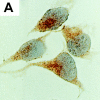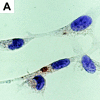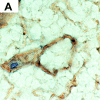Fibroblasts as host cells in latent leishmaniosis
- PMID: 10859337
- PMCID: PMC2193203
- DOI: 10.1084/jem.191.12.2121
Fibroblasts as host cells in latent leishmaniosis
Abstract
Intracellular parasites are known to persist lifelong in mammalian hosts after the clinical cure of the disease, but the mechanisms of persistence are poorly understood. Here, we show by confocal laser microscopy that in the draining lymph nodes of mice that had healed a cutaneous infection with Leishmania major, 40% of the persisting parasites were associated with fibroblasts forming the reticular meshwork of the lymph nodes. In vitro, both promastigotes and amastigotes of L. major infected primary skin or lymph node fibroblasts. Compared with macrophages, cytokine-activated fibroblasts had a reduced ability to express type 2 nitric oxide synthase and to kill intracellular L. major. These data identify fibroblasts as an important host cell for Leishmania during the chronic phase of infection and suggest that they might serve as safe targets for the parasites in clinically latent disease.
Figures
























References
-
- Murray P.J. Defining the requirements for immunological control of mycobacterial infections. Trends Microbiol. 1999;7:366–372. - PubMed
-
- Bogdan C., Röllinghoff M. How do protozoan parasites survive inside macrophages? Parasitol. Today. 1999;15:22–28. - PubMed
-
- Titus R.G., Theodos C.M., Shankar A., Hall L.R. Interactions between Leishmania major and macrophages. In: Zwilling T., Eisenstein T., editors. Macrophage–Pathogen Interactions. Marcel Dekker, Inc; New York: 1993. pp. 437–459. - PubMed
-
- Pearson R.D., de Queiroz Sousa A. Clinical spectrum of leishmaniasis. Clin. Infect. Dis. 1996;22:1–13. - PubMed
-
- Reiner S.L., Locksley R.M. The regulation of immunity to Leishmania major . Annu. Rev. Immunol. 1995;13:151–177. - PubMed
Publication types
MeSH terms
Substances
LinkOut - more resources
Full Text Sources
Other Literature Sources

